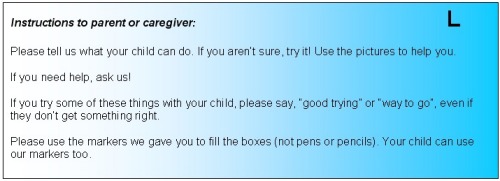Parents' Evaluation of Developmental Status - Developmental Milestones (PEDS:DM)


With PEDS:DM, parents can answer the items in your waiting room or you and your staff can test children directly (although letting parents answer is easier and faster for you, and as accurate). PEDS:DM adds confidence to your decision-making, helps identify areas of delay, focuses referrals, and saves time otherwise spent eliciting skills from children.
Compliance with the AAP's new policy statement (2006, 2009, & 2014)
What is the PEDS:DM?
The PEDS:DM is a new measure that can be used with PEDS (the 10 item measure focused on eliciting and addressing parents' concerns) or by itself. The PEDS:DM consists of 6-8 items per age/encounter and is designed to replace informal milestones checklists (which are notorious for their inability to detect children with problems) with highly accurate items known to predict developmental status. Each item on the PEDS:DM taps a different developmental domain (fine motor, gross motor, expressive language, receptive language, self-help, social-emotional, and for older children, reading and math). Failure on an item, predicts difficulties in that domain, with cutoffs tied to the 16th percentile and below: The point at which children struggle when in school, are likely to be retained in grade, drop-out of high school, etc. The PEDS-DM has sensitivity and specificity between 70% and 97% across ages and developmental domains. So it provides clear critieria for when to refer and meets standards for screening test accuracy.
The PEDS:DM is for children birth to 7-11 years of age. Items are completed by parent report (but can also be administered directly to children). The PEDS:DM has laminated pages on which parents and older children can write with a dry-erase marker or grease pencil (markers and holders are included with the test). The PEDS:DM Recording Form, a single longitudinal screening/surveillance form, is kept in the chart and is the only expendable material required. The Recording Form provides a growth chart for tracking strengths and weaknesses over time.
There is also an assessment-level version (PEDS:DM-AL) of the PEDS:DM for use with programs serving children at risk (e.g, NICU follow-up, Early Intervention services, etc.). This version provides both age-equivalent scores, and determines percentage of delay. It has a reusable form (one per family) for in-depth developmental monitoring.
Below is a sample of items from the PEDS:DM and the directions given to parents. Parents do not see the age ranges for which each form is appropriate (in order to minimize distress for families whose children have delays). The L Form (shown below) is for children 29 - 33 months. In the PEDS:DM manual is a key that associates each DM Form with their age ranges. The PEDS:DM Binder Case includes a scoring template that is laid over the parents' responses. This reveals incorrect answers and the domain into which each question falls. (In the example below, all marked items were optimal responses for the age range). The PEDS:DM Recording Form remains in the chart for the entire 0 - 8 year age range and is the only on-going expense associated with the PEDS:DM (about 2 cents per visit).
PEDS versus PEDS:DM
There's much value in using PEDS and PEDS:DM together and the measures combined require only 16 - 18 questions to be answered per visit.
- PEDS helps you elicit and address parents' concerns, helps focus the visit, reduces "oh by the way" concerns, enhances the "teachable moment", and ensures that visits are truly collaborative.
- The PEDS:DM gives you information on children's progress, facilitates skilled monitoring of development, replaces informal milestones checklists with an accurate one that has clear cutoffs for problematic versus typical development.
- The PEDS:DM clarifies parental concerns (some types of concerns require screening further) and so by using both measures together you can comply with American Academy of Pediatrics' (2006, 2009, & 2014) recommendations for screening and surveillance: eliciting parents' concerns at each visit and measuring children's development.
The case example on the next few pages shows the value of using both PEDS and the PEDS:DM.
Practicalities and Cost
The PEDS:DM Recording Form also includes the PEDS Score Form and a revised PEDS Interpretation Form showing how to make use of the results of both measures. Together PEDS and the PEDS:DM cost about 30 cents per visit, take about 7 minutes for parents to complete, and allow you to bill the 96110 procedure code (X 2) for which reimbursement under Medicaid averages about $10.00 (per screen). You'll still need PEDS Response Forms. If you are using an EMR please contact us for help with integration and licensing.
For additional information on the PEDS:DM in print or for electronic applications, please contact us.
Please let us know if you have questions or comments.
If you still aren't sure you need the PEDS:DM or PEDS, consider this:
If you aren't referring at least 1 in 10 children, preferably closer to 1 in 5 (our national drop-out rate), your early detection methods aren't working!
Additional Information on the PEDS:DM Test
- Talking Points on the PEDS:DM Test
- Why Use PEDS:DM?
- What Are the Components Of PEDS:DM?
- Billing and Coding PEDS:DM
- Benefits of Using PEDS with PEDS:DM
- How To Implement PEDS:DM
- A New Measure for Developmental-Behavioral Surveillance and Screening
- Help For PEDS Users
© Glascoe FP, Robertshaw NS. Parents' Evaluation of Developmental Status: Developmental Milestones (PEDS:DM). Nashville, Tennessee: Ellsworth & Vandermeer Press, LLC 1013 Austin Court, Nolensville, Tennessee 37134, (October, 2006). Phone: 615-776-4121, FAX: 615-776-4119, www.pedstest.com